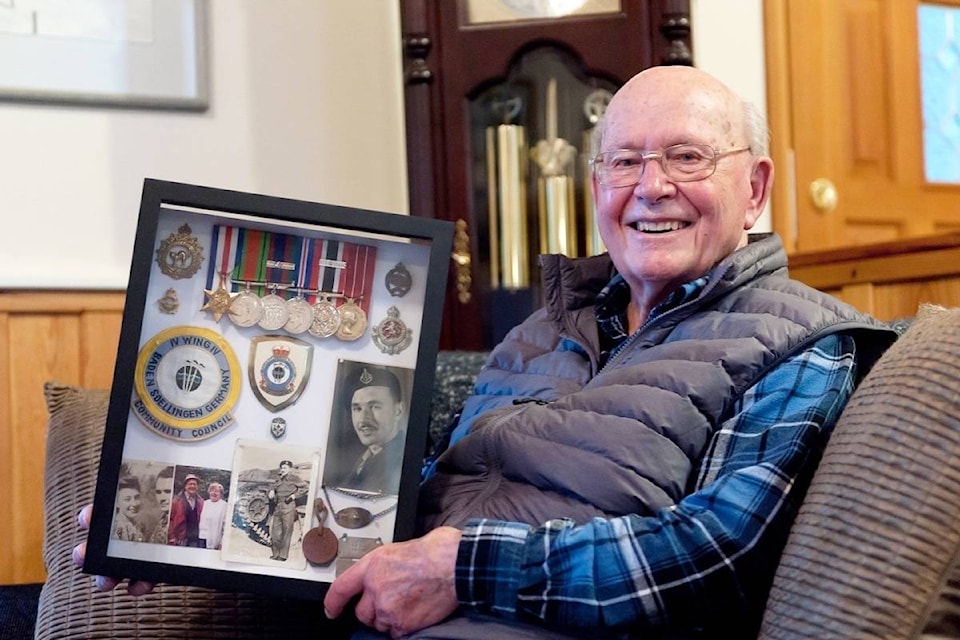Errington’s William “Bill” Cope will never forget where he was on May 8, 1945, when a quiet evening at the Canadian regimental headquarters near Assen, the Netherlands, erupted into a wild and raucous party. After weeks of waiting for the official end of the Second World War, the Canadian forces that led the liberation of the Netherlands had just gotten word the long-awaited armistice had been signed.
While Cope could hear the revelry, he wasn’t exactly in the thick of the celebration.
“I was standing guard that night, outside,” said Cope, now 97. “Everything was quiet, then all of a sudden I hear a big party erupted from the headquarters. I was isolated out there. It was a two-hour shift, so I waited and waited.
“And when the shift ended I went in there and joined it.”
Cope’s varied career with the Canadian Forces included a four-year stint as a tank driver, gunner and instructor during the Second World War and, later, a 16-year enlistment with the Canadian Air Force, during which he was stationed in Germany.
Cope, who was born in April of 1920, shipped out to Europe on Christmas Day, 1942. He left behind his wife of nine month, Stella, who was pregnant with the couple’s first child. Cope would not see Stella — or his young son, David — until 1946, when David was three-and-a-half years old.
“It’s a difficult thing, no argument,” Cope said of the forced separation. He said Stella, who died earlier this year after the couple celebrated their 75th wedding anniversary, went to work punching out mortar shells in a plant in Brighton, Ont.
Meanwhile, Cope made perhaps his most unique contribution to Canadian military history shortly after arriving at the British Fighting Vehicle Proving Establishment, when he became what he believes is the only Canadian to have driven a German Tiger tank (the 57-tonne Sd Kfz 181 Panzerkampfwagen).
“Just before we arrived the British had brought back a Tiger tank from North Africa that had been captured there,” said Cope, who had deployed to Britain as a corporal instructing tank drivers. “It was sitting there and, of course, we all climbed through it and got familiar with it. And I’m dead sure I’m the only Canadian that ever got to drive a German Tiger tank.”
That tank, which can be seen at The Tank Museum in England, remains the only functional Tiger left in the world, according to Cope.
Two years later, Cope would get his first taste of driving and shooting from a tank in combat, though it was not originally his assigned role.
Following the initial infantry troops onto the beaches at Normandy on D-Day in 1944, Cope was working in a tank delivery regiment, hauling tanks and other vehicles and heavy machinery from England to France.
“After our third trip across I was ready to return to England,” said Cope, then 24. “The OC said, ‘You’re not going anywhere,’ and pointed me to a tank.”
Cope was attached to the 5th Canadian Armoured Division which commenced a nearly one-year campaign to liberate the Netherlands from Nazi occupation while punching through heavy resistance. It was a fight that would take nearly 7,600 Canadian lives.
Following the armistice, Cope was billeted with a Dutch teacher and his family, where he remained until January of 1946 before returning home to Stella and their son. The couple would have four children, three of whom remain in the Parksville Qualicum Beach region.
In 1946, though, the young couple initially settled in Owen Sound, Ont., where Cope took a job in the Canadian Pacific Railroad’s freight shed before his true career opportunity came knocking.
“I got word the town had bought a bulldozer,” Cope said, sharing a knowing grin. “So I went up and saw the alderman that was in charge of the works department. And I got the job.”
Cope parlayed his tank-driving training into a career operating heavy construction machinery, and spent nearly 10 years building King’s Highway 401 and working on other projects in Ontario. When the constructon industry suffered a lull in 1954-55, Cope said, he took a job as a civilian at the CFB Trenton airfield.
“I did that for about a year, and then I said, ‘These guys are walking around in pretty uniforms,’” Cope recalls. “So I joined.”
He would spend 16 years working in ground transport in the Air Force, much of it stationed in Germany — this time with Stella and their children along. The family made several trips back to the Netherlands to reunite with Cope’s 1945 billet family. He said he also took the occasion to visit the Groesbeek Canadian War Cemetery, an experience that soured him on the idea of ever returning to Europe for a veterans’ anniversary reunion or commemoration.
“You go around, thinking maybe you can find (the graves of) some of the guys you knew,” Cope said. “Those cemeteries are so huge; it’s mind-boggling. We only did that once and I said, ‘That’s enough.’”
